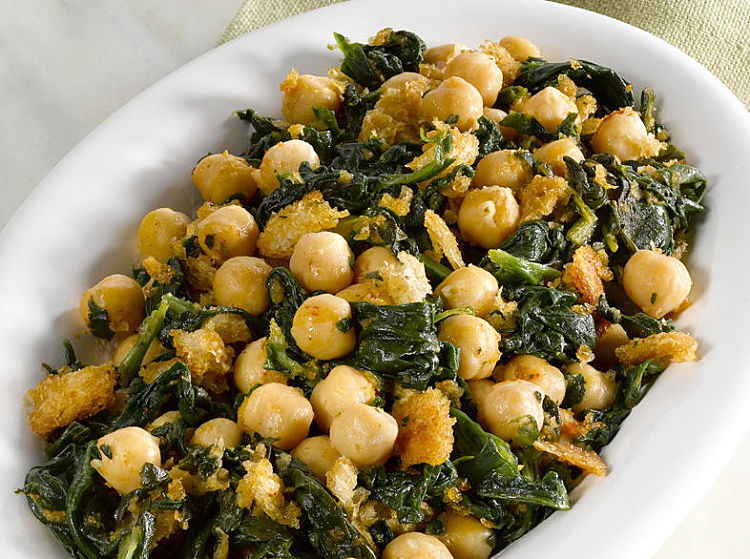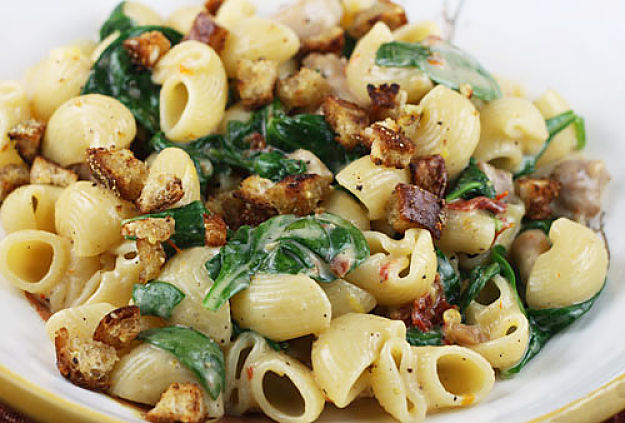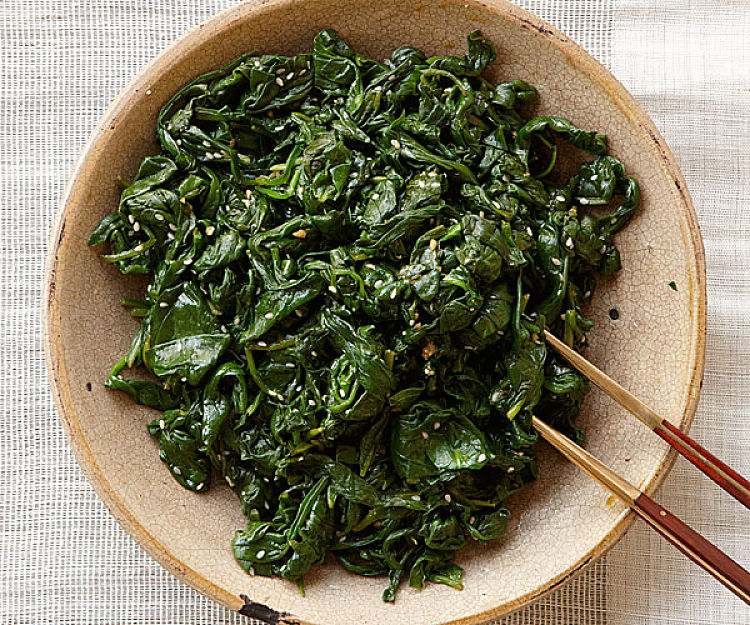Health Benefits Spinach Nutritional Values, Spinach Culinary Uses
The health benefits of spinach are showcased by its outstanding nutritional values supporting its popularity in its many culinary uses as a green vegetable for main meals and as an addition to various pies and quiches, pizzas, salads and stir-fies.
Spinach's tender, crispy, dark green leaves are favorite ingredient that is rich in fiber, antioxidants vitamins and minerals.
Spinach has very high levels of vitamin C and is rich in riboflavin, folate, magnesium, vitamin A, potassium, as well as vitamins B6, E and thiamin. Spinach is a rich source of iron, but much of this is unavailable for absorption due to oxalic acid, high levels of which can cause gout and kidney stones.
So spinach should be eaten in moderation and mixed with other vegetables.
Often referred to as English Spinach, to distinguish it from other Asian plants its scientific name is Spinacia oleracea and it belongs to the Amaranthaceae family and it is native to central and southwestern Asia.
Closest relatives used as vegetables are chard and orache ('French spinach'). There are many unrelated plants called spinach such as New Zealand spinach, Water spinach, Malabar spinach and various Asian greens.
This article highlights the nutritional values of spinach, its health benefits and its many and varied culinary uses.
Foods with High Oxalate Content
| Raw Vegetable | Oxalate content (mg per 100 gram serving) |
|---|---|
| Spinach | 750 |
| Beet greens | 610 |
| Okra | 146 |
| Parsley | 100 |
| Leeks | 89 |
| Collard greens | 74 |
Iron In Spinach and Warnings about Spinach's High Oxalic Acid Content
In popular culture, spinach is a rich source of iron exemplified by the cartoon character 'Popeye the Sailor Man' who got strong after eating spinach. It is true that there is a lot of iron in spinach with 60 gram serving of boiled spinach containing about 2 mg of iron whereas most other green vegetables only have half this amount.
However, the actual amount of this that is available to this may only be 2-5% of this, because it is non-haeme iron(not derived from haemoglobin in meat) that is absorbed slowly from food. Also spinach contains relatively high levels of oxalate that binds to the iron and forms ferrous oxalate which block the absorption.
Spinach also has relatively a high amounts of calcium, but oxalate binds with calcium as well, decreasing its absorption. In comparison the body can absorb and use about half of the calcium contained in broccoli (25 g of 50 g present), yet only around 5 % of the calcium in spinach (5g of 100 g present).
Iron overload cause by too much iron in the diet can also be a problem.
Oxalate is renowned as one of several factors that can contribute to kidney stones and gout and spinach should be avoided by people who have a history of kidney stones or a high risk of developing them.
The table below lists high oxlate food. Several other factors contribute kidney stones including genetic tendency, excess calcium intake, excess vitamin D, high intake of animal protein, prolonged immobility, renal tubular acidosis,hyperparathyroidism and excessive dietary fiber.
Foods that are high in oxalate are spinach, beet leaves, purslane leaves, collards, swiss chard (leaves and stalks), okra, parsley, leeks, quinoa, rhubarb, parsley, amaranth leaves, sorrel.
Foods that are low in oxalate are: Dandelion greens, kale, watercress, most fruits,kale, broccoli, tomatoes, asparagus, mustard greens, escarole, turnip greens, cabbage and most other greens.
Nutrition Facts for Spinach
| Serving 100 g | Nutrient Value | % Recommended Daily Allowance |
|---|---|---|
| Energy | 23 Cal | 1% |
| Carbohydrates | 3.63 g | 3% |
| Protein | 2.86 g | 5% |
| Total Fat | 0.39 g | 1.50% |
| Cholesterol | 0 mg | 0% |
| Dietary Fiber | 2.2 g | 6% |
| Vitamins | ||
| Folates | 194 mcg | 48.50% |
| Niacin | 0.72 mg | 4.50% |
| Pantothenic acid | 0.06 mg | 1% |
| Pyridoxine | 0.2 mg | 15% |
| Riboflavin | 0.19 mg | 14.50% |
| Thiamin | 0.08 mg | 6.50% |
| Vitamin A | 9377 IU | 312% |
| Vitamin C | 28.1 mg | 47% |
| Vitamin E | 2.03 mg | 13.50% |
| Vitamin K | 482.9 mcg | 402% |
| Electrolytes | ||
| Sodium | 79 mg | 5% |
| Potassium | 558 mg | 12% |
| Minerals | ||
| Calcium | 99 mg | 10% |
| Copper | 0.13 mg | 14% |
| Iron | 2.71 mg | 34% |
| Magnesium | 79 mg | 20% |
| Manganese | 0.9 mg | 39% |
| Zinc | 0.53 mg | 5% |
| Phyto-nutrients | ||
| Carotene-beta | 5626 mcg | -- |
| Crypto-xanthin-beta | 0 mcg | -- |
| Lutein-zeaxanthin | 12198 mcg | -- |
Health Benefits of Spinach
The two tables show the nutrition facts for spinach in relation or other green vegetables chard, swiss, celery, kale, endive, beet greens and broccoli.
Spinach has a high nutritional value and is rich in many key nutrients such as antioxidants, especially when fresh, quickly boiled or lightly steamed, or used in stir fries. Prolonged boiling can destroy its value. The key nutrients are vitamins A, C, E, B6 and K. Spinach is also rich in omega-3 fatty acids, selenium, niacin, zinc, phosphorus, protein, copper, potassium, calcium, manganese, magnesium, vitamin B2, iron, betaine and folate. Recently, opioid peptides called rubiscolins have been shown to occur in spinach.
The main features of the health benefits are:
- Spinach is very low in fats and calories and fats (100 g of raw leaves provide just 23 calories). It is also rich in soluble dietary fiber ( 2.3 g per 100 g) and protein (2.8 g per 100 g) for which these values are higher than most of the other green vegetables.
- Fresh spinach leaves are rich source of various anti-oxidant compounds such as vitamins A and C; and other antioxidants such as beta-carotene, lutein, and zea-xanthin.
- 100 g of Spinach provides all of the of the recommended daily requirements for vitamin-K requirements and spinach is the richest source of folate for the comparable vegetables with about 200 micrograms per 100g of fresh spinach.
- Spinach is also a rich source of many B-complex vitamins, particularly thiamin, (vitamin B-1), riboflavin, folates, vitamin- B6 (pyridoxine) and niacin.
- Spinach is a good source of minerals such as potassium, magnesium, manganese, zinc and copper, with values exceeding those in other vegetables.
Comparison of Spinach Nutrients with Alternatives
| serving 100 g | spinach | chard, swiss | celery | kale | endive | beet greens | broccoli |
|---|---|---|---|---|---|---|---|
| Macronutrients | |||||||
| Calories (kcal) | 23 | 19 | 16 | 51 | 16 | 21 | 34 |
| Protein (g) | 2.87 | 1.81 | 0.69 | 3.3 | 1.24 | 2.21 | 2.82 |
| Total Fat (g) | 0.4 | 0.19 | 0.18 | 0.7 | 0.2 | 0.13 | 0.37 |
| Total Carbohydrates (g) | 3.63 | 3.75 | 2.98 | 10.01 | 3.36 | 4.34 | 6.64 |
| Dietary Fiber (g) | 2.33 | 1.67 | 1.63 | 1.94 | 3.2 | 3.68 | 2.64 |
| Sugar (g) | 0.43 | 1.11 | 1.83 | 0.24 | 0.5 | 1.7 | |
| Vitamins | |||||||
| Vitamin C (mg) | 28 | 30 | 3.13 | 120 | 6.4 | 30 | 89.23 |
| Thiamin (mg) | 0.08 | 0.04 | 0.02 | 0.11 | 0.08 | 0.1 | 0.07 |
| Riboflavin (mg) | 0.19 | 0.09 | 0.06 | 0.13 | 0.07 | 0.22 | 0.12 |
| Niacin (mg) | 0.72 | 0.4 | 0.32 | 1 | 0.4 | 0.4 | 0.64 |
| Pantothenic Acid (mg) | 0.07 | 0.17 | 0.25 | 0.09 | 0.9 | 0.25 | 0.57 |
| Vitamin B6 (mg) | 0.2 | 0.1 | 0.07 | 0.27 | 0.02 | 0.11 | 0.17 |
| Folate (mcg) | 193.33 | 13.89 | 36.25 | 28.36 | 142 | 15.79 | 62.64 |
| Vitamin B12 (mcg) | 0 | 0 | 0 | 0 | 0 | 0 | 0 |
| Vitamin A (IU) | 9376 | 6116 | 448 | 15376 | 2168 | 6326 | 623 |
| Vitamin E (mg) | 2.03 | 1.89 | 0.28 | 0.44 | 1.5 | 0.78 | |
| Vitamin K (mcg) | 483 | 830 | 29.25 | 817.01 | 231 | 400 | 101.65 |
| Minerals | |||||||
| Calcium (mg) | 100 | 50 | 40 | 134.33 | 52 | 115.79 | 47.25 |
| Iron (mg) | 2.7 | 1.81 | 0.2 | 1.7 | 0.82 | 2.58 | 0.73 |
| Magnesium (mg) | 80 | 80.56 | 11.25 | 34.33 | 16 | 71.05 | 20.88 |
| Phosphorus (mg) | 50 | 47.22 | 23.75 | 56.72 | 28 | 42.11 | 65.93 |
| Potassium (mg) | 556.67 | 377.78 | 260 | 446.27 | 314 | 763.16 | 316.48 |
| Sodium (mg) | 80 | 213.89 | 80 | 43.28 | 22 | 226.32 | 32.97 |
| Zinc (mg) | 0.53 | 0.36 | 0.13 | 0.43 | 0.8 | 0.37 | 0.41 |
| Copper (mg) | 0.13 | 0.18 | 0.04 | 0.29 | 0.1 | 0.19 | 0.05 |
| Manganese (mg) | 0.9 | 0.37 | 0.1 | 0.77 | 0.42 | 0.39 | 0.21 |
| Selenium (mcg) | 1 | 0.83 | 0.38 | 0.9 | 0.2 | 0.79 | 2.53 |
| Fatty Acids | |||||||
| Saturated Fat (g) | 0.06 | 0.03 | 0.04 | 0.09 | 0.05 | 0.02 | 0.04 |
| Monounsaturated Fat (g) | 0.01 | 0.04 | 0.03 | 0.05 | 0 | 0.03 | 0.01 |
| Polyunsaturated¢Fat (g) | 0.17 | 0.07 | 0.08 | 0.34 | 0.09 | 0.04 | 0.04 |
Culinary Uses for Spinach
Spinach is sold loose, in bunches of fresh spinach, packaged fresh in bags, frozen or canned.
Fresh spinach can lose its load of nutrients during storage beyond a couple of days.
To prepare fresh spinach wash the leaves thoroughly in clean running water and then rinsed in salt water.
Trim away any tough stems.
The raw leaves can be used individually or chopped for use in various recipes.
Serving tips include:
Raw fresh spinach can be added to salads, veggie burgers pasta source or as juice.
The antioxidant properties are rapidly lost though steaming, boiling or frying and so minimal cooking is recommended.
Spinach can be added to noodles, pie, pasta, quiches, various rice preparations, soups as well as in baby foods. It goes well with feta cheese
You can chopped fresh or frozen spinach to lasagna and other pasta dishes to add color and nutrients
Spinach dips can be eaten with whole grain breads as a quick snack.
Use fresh spinach to replace lettuce in sandwiches and other lunch items.
Add chopped fresh or frozen spinach to frittatas and omelets.




